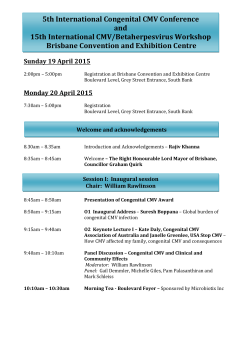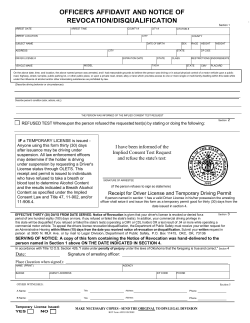
Downloaded from by guest on September 9, 2014
cm 1996;22 (June) Brief Reports 1J J7 7. Goldschneider I, Gotschlich EC, Artenstein MS. Human immunity to the meningococcus. I. The role of humoral annbody. J Exp Moo 1969; 129:1307-26. 8. Keller AJ, Urbaniak SJ. Intensive plasma exchange on the cell separator: effects on serum immunoglobulin and complement components. Br J Haematoll978; 38:531-40. 9. Rodnitzky RL. Complications of plasma exchange in neurological patients. Arch Neurol 1982;39:352-4. Severe Acute Cytomegalovirus Sialadenitis in an Immunocompetent Adult: Case Report level of antinuclear antibodies was slightly elevated. The serum angiotensin converting enzyme level was normal, and an anteroposterior radiograph of the chest did not show any signs of sarcoidosis or other diseases. An ultrasonogram of the salivary glands confirmed diffuse enlargement ofboth the parotid and submandibular glands. Echogenicity was decreased, and there was no sign of sialolithiasis, neoplasms, cystic lesions, or abscesses. Examination of the abdomen showed only a slightly increased echographic texture of the liver. Examination of biopsy specimens from the left submandibular gland and the minor salivary glands in the lower lip demonstrated hyperplastic epithelium with predominantly lymphocytic infiltrate CD8+, UCHLl +, and focal L26+ and some neutrophilic granulo- In the majority of immunocompetent adults, cytomegalovirus (CMV) causes a latent, asymptomatic infection. Occasionally, a mild, febrile, self-limiting mononucleosis-like illness is observed. However, CMV is an important human pathogen in utero and in immunocompromised hosts; in such settings, CMV infection may result in severe diseases including pneumonia, hepatitis, chorioretinitis, hematologic abnormalities, and involvement of the gastrointestinal tract and the CNS [I]. CMV has a well-established tropism for the salivary glands, but even among patients with AIDS, CMV sialadenitis is rare and usually presents as painful salivary gland swelling [2]. We describe an immunocompetent adult with severe acute sialadenitis of all head salivary glands. The patient recovered after receiving symptomatic therapy for I month. A 57-year-old man presented with a 4-day history of sore throat, fever, chills, fatigue, arthralgia, and painful preauricular and submandibular swelling. Despite administration of antibiotics and anti-inflammatory agents, the infection progressed, and he complained of increasing anorexia, exertional dyspnea, and aphagia because of severe xerostomia. Physical examination on admission revealed painful, pasty, and diffuse enlargement of both parotid glands and submandibular glands (figure 1). The oral cavity was extremely dry and erythematous. No saliva was expelled from the salivary duct orifices when the salivary glands were massaged. The tonsils were mildly hyperplastic, without purulent exudate. The patient was sweaty and in mild respiratory distress, and he had cervical lymphadenopathy. Findings on general physical examination were unremarkable. His temperature, pulse, and blood pressure were normal. The patient's medical history was remarkable only for a gastric ulcer that was treated with a Billroth II procedure 20 years previously. During the previous 2 years, he had not left Germany. Laboratory tests showed elevated levels ofaspartate aminotransferase (81 U/L) and alanine aminotransferase (49 U/L). The amylase level was 177 U/L, and the WBC count was 22.6 X 109/L with 81 % neutrophils and 8% lymphocytes. The erythrocyte sedimentation rate was elevated at 110 mm/h. Levels of extractable nuclear antigens, cytoplasmic anti-neutrophil cytoplasmic antibodies, perinuclear anti-neutrophil cytoplasmic antibodies, double-stranded DNA antibodies, and rheumatoid factor were normal. Only the Reprints or correspondence: Dr. O. Guntinas-Lichius, Klinik fur Hals-, Nasen-, und Ohrenheilkunde der Universitiit zu Koln, Lindenthal, 0-50924 Cologne, Germany. Clinical Infectious Diseases 1996;22:1117-8 © 1996 by The University of Chicago. All rights reserved. 1058-4838/9612206-0040$02.00 Figure l. Swelling of the submandibular and parotid glands of a patient with CMV sialadenitis; the patient was noted to be pale and sweaty on admission. Downloaded from http://cid.oxfordjournals.org/ by guest on September 9, 2014 4. Rose HD, Lenz IE, Sheth NK. Meningococcal pneumonia: a source of nosocomial infection. Arch Intern Med 1981; 141 :575-7. 5. Broome CV. The carrier state, Neisseria meningitidis. J Antimicrob Chemother 1986; 18(supplA):25-34. 6. Goldschneider I, Gotschlich EC, Artenstein MS. Human immunity to the meningococcus. II. The development of natural immunity J Exp Med 1%9; 129:1327-48. 1118 Brief Reports 1996; 22 (June) Elevation of liver enzyme levels and leukocytosis have occurred in adults with CMV mononucleosis [4]. The clinical course, laboratory findings, and spontaneous recovery of our patient resembled the course ofCMV mononucleosis [1], even though he had symptomatic .CMV sialadenitis. Even among immunosuppressed hosts, clinical manifestations of CMV infection of the salivary glands are rare [1, 4, 5]; however, if clinically manifest infection occurs, the parotid gland is affected exclusively [1]. In the present case, treatment with ganciclovir or foscamet was not indicated [6], since the patient was immunocompetent. The biopsy specimens were not obtained at the climax of the infection but at an early stage of recovery. Thus, only a few epithelial cells were positive for CMV when they were studied by IRC techniques and ISH. Leukocytes had destroyed CMV-infected cells, which were cleared through the ducts (detritus). Noninfected epithelium was positive for PCNA; since PCNA may be positive as well during DNA repair [7] or during proliferation ofepithelium [8], staining for the presence of p53 antigen was performed to detect significant prereparative cell-cycle arrest. Positive IRC and ISH reactions in some epithelial cells showed remnants of fading CMV infection. As expected, the patient fully recovered, without major scarification, after 30 days with symptomatic treatment. Orlando Guntinas-Lichius, Mathias Wagner, Gerhard R. F. Krueger, Michael Streppel, Martin Voessing, and Eberhard Stennert Department of Otorhinolaryngology and the Immunopathology Section, Institute of Pathology, University of Cologne, Cologne, Germany; and the Department ofPathology and Laboratory Medicine, University of Texas Medical School, Houston, Texas, USA References I. Alford CA, Britt WJ. Cytomegalovirus. In: Roizman B, Whitley RJ, Lopez C, eds. The human herpesviruses. New York: Raven, 1993:227-55. 2. Wax TD, Layfield LJ, Zaleski S, et al. Cytomegalovirus sialadenitis in patients with acquired immunodeficiency syndrome. Diagn Cytopathol 1994; 10:169-74. 3. Krueger GRF, Roewert J. Klinische Immunpathologie der Zytomegalievirus (CMV)-Infektion. AIDS Forschung 1988;5:243-57. 4. Oill PA, Fiala M, Schofferman J, Byfield PE, Guze LB. Cytomegalovirus mononucleosis in a healthy adult. Am J Med 1977;62:413-7. 5. Schiodt M. mY-associated salivary gland disease: review. Oral Surg Oral Med Oral Pathol1992;73:164-7. 6. Meyers JD. Management of cytomegalovirus infection. Am J Med 1988; 85(suppI2A):102-6. 7. Shivji KK, Kenny MK, Wood RD. Proliferating cell nuclear antigen (PCNA) is required for DNA excision repair. Cell 1992; 69:367-74. 8. Mathews MB, Bernstein RM, Franza JR, Garrels n. Identity ofthe proliferating cell nuclear antigen and cyclin. Nature 1984;309:374-6. Downloaded from http://cid.oxfordjournals.org/ by guest on September 9, 2014 cytes. The terminal ducts were full of purulent detritus. Further immunohistochemical (IHC) investigations (by the alkaline phosphatase anti-alkaline phosphatase technique) and in situ hybridization (ISH) revealed CMV in epithelial cells, without typical owl's eye cells; Epstein-Barr virus (EBV) and human herpesvirus 6 were not detected. The epithelium was highly positive for proliferating cell nuclear antigen (PCNA) and negative for p53 antigen. Virological examinations confirmed an acute CMV infection: the titer of antibodies to CMV detected by CF was 1: > 160, and an ELISA for IgM and IgG antibodies to CMV was positive. These values were confirmed by retesting several blood samples. Examinations for IgM antibodies to mumps virus, herpes simplex virus, coxsackie B virus, varicella-zoster virus, and EBV were negative, as was an ELISA for HIV 1, RIV 2, and HIV 1 p24 antigen. CMV chorioretinitis and CMV infection of the gastrointestinal tract and CNS were ruled out. Throughout his hospital course, the patient had a normal CD4 cell count and a normal CD8 cell count. Immunoelectrophoresis revealed only a transient increase in IgM, with a level of 4.61 gIL during the first 3 weeks. Levels of the other Ig subclasses and the complement factors C3 and C4 were normal. After symptomatic treatment with amoxicillin/sulbactam and administration of iv fluids, parenteral nutrition, diclofenac suppository, and oral tramadol drops, the patient's xerostomia decreased by day 14 after admission, and he started to take fluids orally. Initial treatment with a 500-mg bolus ofmethylprednisolone failed, and the drug was withdrawn after CMV infection was diagnosed. Day by day, he continued to convalesce; an ELISA for IgM antibody to CMV was only weakly positive from day 14 onward, and CF titers of antibody to CMV dropped to 1:40 after 14 days and to 1:20 after 1 month. Liver enzyme levels and the WBC count decreased daily and were nearly normal at demission. After 18 days the patient started to eat, his salivary glands were less painful, and massage of the glands on day 28 yielded scanty saliva. After 30 days the patient left the hospital and was followed up monthly; follow-up included blood tests. After 2 months, all hematologic parameters had become normal. After 12 months, serologic tests for antibodies to RIV remained negative, and follow-up ceased. The diagnosis of fulminant primary CMV sialadenitis in this immunocompentent adult was based on an elevated CF titer of antibodies to CMV' a positive IgM titer, and detection of CMV in a salivary gland. Patients whose sera are positive for heterophil agglutinin or IgM antibody to EBV can have false-positive titers ofIgM antibody to CMV [1, 3]; however, our patient's serum was negative for both heterophil agglutinin and IgM antibody to EBV. cm
© Copyright 2025





















